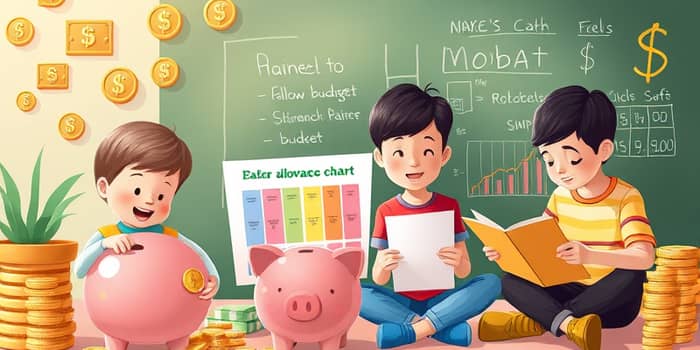Building financial knowledge early empowers children to make sound money decisions throughout life. From piggy banks to budgeting apps, every lesson counts.
The Current State of Youth Financial Literacy
Despite growing awareness of personal finance, many young people enter adulthood without the basics. Recent research shows that about 22% of U.S. teenagers lack fundamental money skills, and 74% report low confidence in handling personal finances. This significant financial knowledge gap has far-reaching consequences, from credit card debt to difficulty saving for emergencies.
Yet interest in learning remains high. Roughly 68% of teens would eagerly enroll in a financial literacy course if it were offered, but only 31% have such access through their schools. Furthermore, 73% of teens express a clear desire to improve their money management knowledge.
- 22% of U.S. teens lack basic financial skills
- 74% of teens lack confidence in personal finance
- 68% would enroll in a finance course if available
- 31% have access to school-based courses
The Importance of Early Financial Education
Studies indicate that money habits form as early as age 7 to 9, making early instruction vital. Starting lessons young can anchor healthy practices that last a lifetime. Experts emphasize the need to start financial education at a young age so children view money as a tool rather than a mystery.
Remarkably, benefits of high school finance lessons are still detectable 12 years after graduation, underscoring the lasting impact of structured education.
Sources of Financial Education
Young people learn about money through a variety of channels, but these sources are uneven in scope and depth.
- 75% of teens rely primarily on family for financial guidance
- 52% report learning about money at school
- Many schools offer minimal preparation, leading to academic success and financial failure for some graduates
Current Educational Landscape
Progress toward formal financial literacy requirements varies by state. Only 35 states mandate a personal finance course for graduation, leaving millions of students without standardized instruction.
Some districts have begun integrating personal finance into existing courses like math or social studies, but inconsistency across regions perpetuates gaps in knowledge and skills.
Financial Literacy Milestones by Age
Early Childhood (Ages 3–6): Children learn the concept of money as a medium of exchange. By age 6, many start understanding allowances and can practice simple savings by depositing coins into a piggy bank or kids' debit card.
Middle Childhood (Ages 7–9): This stage is crucial for internalizing the value of money. Young learners begin linking effort to income, setting savings goals, and delaying gratification for larger rewards.
Pre-teens and Teens (Ages 10–18): Older students tackle advanced topics such as budgeting, credit basics, and the principles of investing. Data shows the average allowance for a 7-year-old is about $5.06 per week, a practical tool for real-world practice.
Educational Resources and Approaches
Parents, teachers, and third-party providers can leverage diverse materials to strengthen financial teaching:
Comprehensive programs with over 90 lessons blend interactive activities and readings, adaptable for classroom or home delivery. Hands-on tools like budget worksheets, simulated market games, and digital apps help reinforce key concepts through practice.
Embedding financial lessons into core subjects ensures students encounter money topics regularly, making finance part of everyday learning rather than an afterthought.
The Cost of Financial Illiteracy
Poor financial knowledge carries a heavy burden. The International Federation of Accountants estimates financial illiteracy drains nearly half a billion dollars from the U.S. economy each year.
When young people lack skills to manage debt, establish credit, or save effectively, they face long-term consequences that affect job opportunities, stress levels, and overall financial stability.
Recommendations for Improvement
To bridge the gap and foster stronger money skills, stakeholders at every level must act:
- Parents should initiate open, age-appropriate money talks at home
- Schools need to adopt a standardized approach to financial education in their curricula
- Teachers require professional development to feel confident teaching personal finance
- Policy makers and program sponsors must be accountable for measurable outcomes
Intergenerational Benefits
Financial education not only aids students but also their families and educators. Parents of teens with formal money instruction report higher credit scores and fewer loan defaults.
Teachers who integrate personal finance into their lessons often see improvements in their own savings habits and overall money confidence.
Conclusion: Building a Financially Literate Future
Teaching money lessons at any age sets the foundation for lifelong financial well-being. By combining early habits with structured high school programs, communities can empower the next generation to make informed money decisions.
Together—parents, educators, and policy makers—can chart a course toward stronger financial futures for all children. The journey begins with one coin, one lesson, and one conversation at a time.
References
- https://www.financialeducatorscouncil.org/youth-financial-literacy-statistics/
- https://jausa.ja.org/news/blog/teens-want-financial-literacy-education-but-many-schools-don-t-offer-it
- https://www.edutopia.org/article/financial-literacy-education-yields-big-returns/
- https://www.nefe.org/news/nefe-digest/2017/can-america-compete.aspx
- https://www.nea.org/resource-library/financial-literacy-economic-inequality
- https://www.gohenry.com/us/blog/financial-education/financial-milestones-for-kids-an-age-by-age-guide
- https://www.financialeducatorscouncil.org/financial-literacy-for-kids/
- https://cricketmedia.com/news-press/crickettogether-news-resources/building-money-smarts-how-early-financial-education-empowers-the-next-generation/










